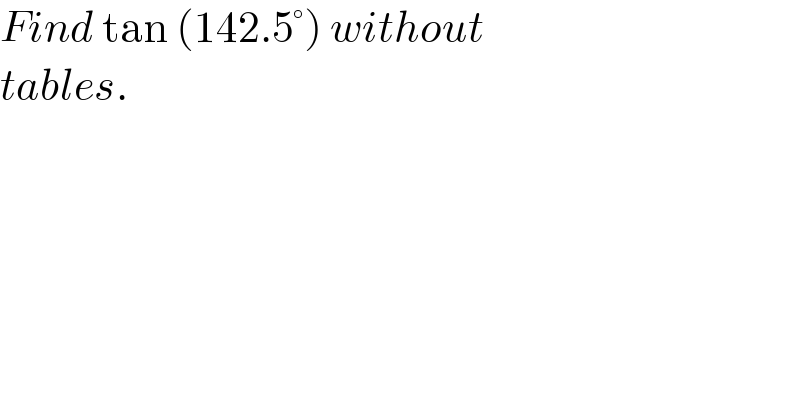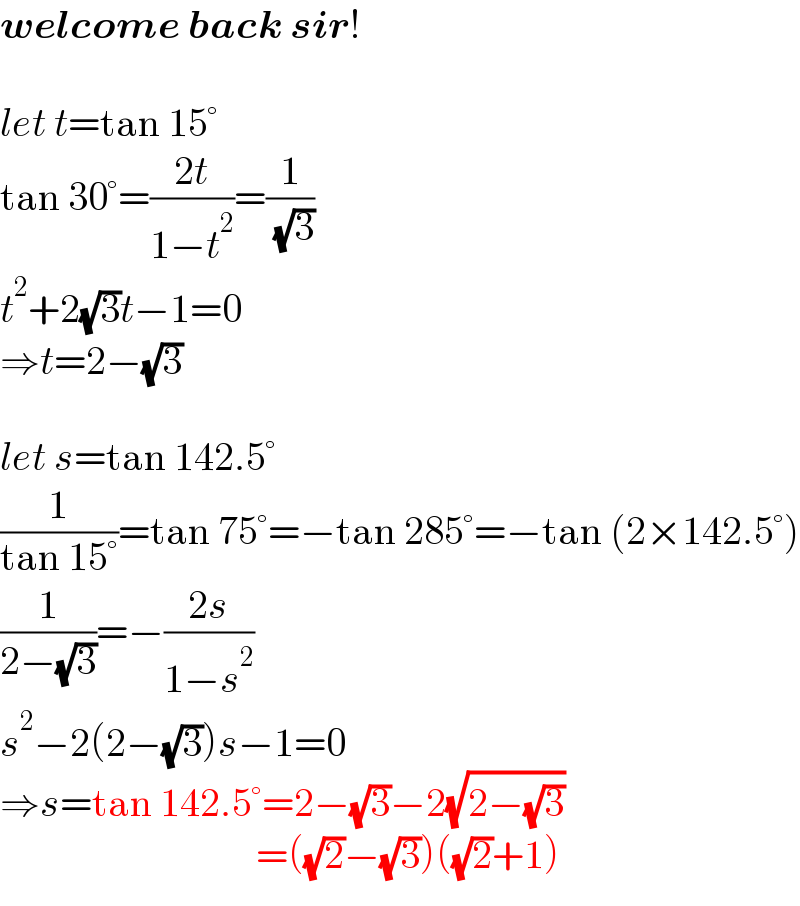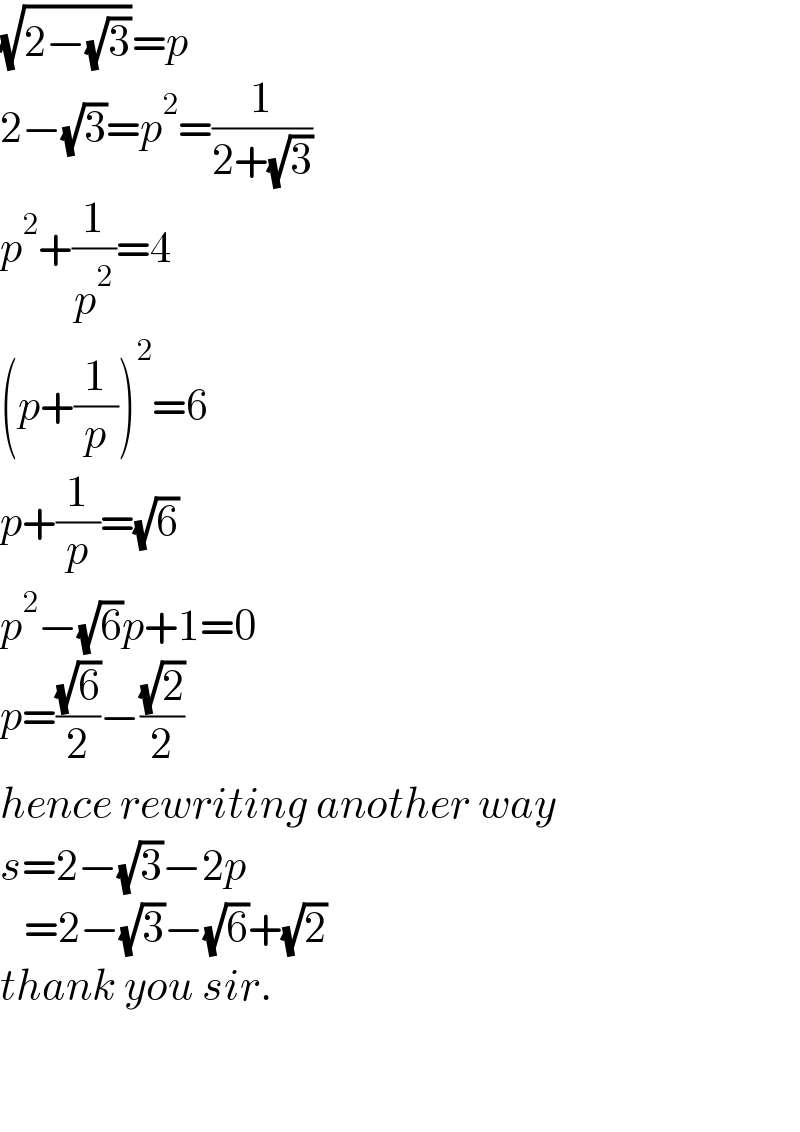Question Number 173447 by ajfour last updated on 11/Jul/22

$${Find}\:\mathrm{tan}\:\left(\mathrm{142}.\mathrm{5}°\right)\:{without} \\ $$$${tables}. \\ $$
Commented by mr W last updated on 12/Jul/22

$$\boldsymbol{{welcome}}\:\boldsymbol{{back}}\:\boldsymbol{{sir}}! \\ $$$$ \\ $$$${let}\:{t}=\mathrm{tan}\:\mathrm{15}° \\ $$$$\mathrm{tan}\:\mathrm{30}°=\frac{\mathrm{2}{t}}{\mathrm{1}−{t}^{\mathrm{2}} }=\frac{\mathrm{1}}{\:\sqrt{\mathrm{3}}} \\ $$$${t}^{\mathrm{2}} +\mathrm{2}\sqrt{\mathrm{3}}{t}−\mathrm{1}=\mathrm{0} \\ $$$$\Rightarrow{t}=\mathrm{2}−\sqrt{\mathrm{3}} \\ $$$$ \\ $$$${let}\:{s}=\mathrm{tan}\:\mathrm{142}.\mathrm{5}° \\ $$$$\frac{\mathrm{1}}{\mathrm{tan}\:\mathrm{15}°}=\mathrm{tan}\:\mathrm{75}°=−\mathrm{tan}\:\mathrm{285}°=−\mathrm{tan}\:\left(\mathrm{2}×\mathrm{142}.\mathrm{5}°\right) \\ $$$$\frac{\mathrm{1}}{\mathrm{2}−\sqrt{\mathrm{3}}}=−\frac{\mathrm{2}{s}}{\mathrm{1}−{s}^{\mathrm{2}} } \\ $$$${s}^{\mathrm{2}} −\mathrm{2}\left(\mathrm{2}−\sqrt{\mathrm{3}}\right){s}−\mathrm{1}=\mathrm{0} \\ $$$$\Rightarrow{s}=\mathrm{tan}\:\mathrm{142}.\mathrm{5}°=\mathrm{2}−\sqrt{\mathrm{3}}−\mathrm{2}\sqrt{\mathrm{2}−\sqrt{\mathrm{3}}} \\ $$$$\:\:\:\:\:\:\:\:\:\:\:\:\:\:\:\:\:\:\:\:\:\:\:\:\:\:\:\:\:\:\:\:=\left(\sqrt{\mathrm{2}}−\sqrt{\mathrm{3}}\right)\left(\sqrt{\mathrm{2}}+\mathrm{1}\right) \\ $$
Commented by ajfour last updated on 11/Jul/22

$$\sqrt{\mathrm{2}−\sqrt{\mathrm{3}}}={p} \\ $$$$\mathrm{2}−\sqrt{\mathrm{3}}={p}^{\mathrm{2}} =\frac{\mathrm{1}}{\mathrm{2}+\sqrt{\mathrm{3}}} \\ $$$${p}^{\mathrm{2}} +\frac{\mathrm{1}}{{p}^{\mathrm{2}} }=\mathrm{4} \\ $$$$\left({p}+\frac{\mathrm{1}}{{p}}\right)^{\mathrm{2}} =\mathrm{6} \\ $$$${p}+\frac{\mathrm{1}}{{p}}=\sqrt{\mathrm{6}} \\ $$$${p}^{\mathrm{2}} −\sqrt{\mathrm{6}}{p}+\mathrm{1}=\mathrm{0} \\ $$$${p}=\frac{\sqrt{\mathrm{6}}}{\mathrm{2}}−\frac{\sqrt{\mathrm{2}}}{\mathrm{2}} \\ $$$${hence}\:{rewriting}\:{another}\:{way} \\ $$$${s}=\mathrm{2}−\sqrt{\mathrm{3}}−\mathrm{2}{p} \\ $$$$\:\:\:=\mathrm{2}−\sqrt{\mathrm{3}}−\sqrt{\mathrm{6}}+\sqrt{\mathrm{2}} \\ $$$${thank}\:{you}\:{sir}. \\ $$$$ \\ $$$$ \\ $$
Commented by Tawa11 last updated on 11/Jul/22

$$\mathrm{Great}\:\mathrm{sirs} \\ $$
Commented by Tawa11 last updated on 13/Jul/22

$$\mathrm{Great}\:\mathrm{sir} \\ $$
